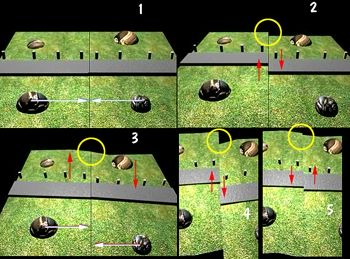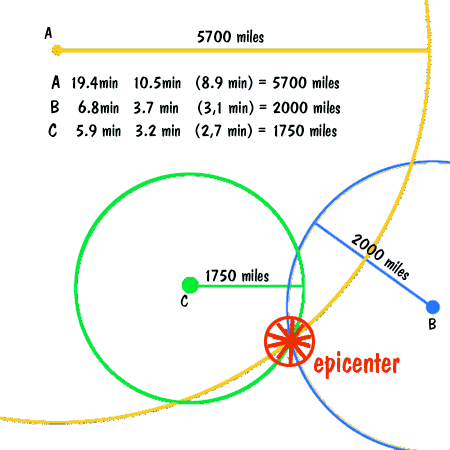
1.) Rest State = no movement - notice the boulders on each side of the fault are roughly across from one another.
2.) Movement without building energy - fault slides smoothly - no earthquake just slow even movement.
3.) Sides of fault have moved - boulders are no longer across from one another, but fault itself is still stationary - building up energy.
4.) Fault releases and give off quick energy - fault moves rapidly in one direction.
5.) Fault rebounds in opposite direction and oscillates until movement stops.

To locate an epicenter we need to know the time it takes for the 2 types of waves to reach 3 different measuring stations. The time differentials can be used to triangulate the center.
The seismograph is the instrument used to measure an earthquake.
The point at which the energy is first released is called the focus ... or earthquake focus. In reality the focal point is always buried and what is reported is the epicenter. This is the spot directly above the true focus of the quake. In reality the point is not really a point, but rather an area.
The waves spread from the focus and move outward. They are called seismic waves. Seismic waves occur in two families:
1.) Body wave: based on the two ways a body (rock) can be deformed.
2.) Surface waves: which travel totally along the surface.
Body waves are similar to light or sound waves and are basically rhythmic compressions.
Surface waves are more like the waves on the ocean and are sinusoidal.
The first type of body wave is a pure compressional wave and is called the "P" or Primary wave. It is the fastest traveling wave and can pass through gases, liquids or solids. This is because gases, liquids, and solids can be compressed to greater density or can be expanded to lower density. (Speed is about 6 km/sec - 3.7mps - 20K feet/sec )
The second type of wave ("S"-wave) is called a shear wave. They transmit themselves by shape changing the material through which they pass. Since gases and liquids cannot change themselves back to an initial shape, they do not pass S waves. Solids are the only material that can pass an S wave. (Speed is about 3.5 km/sec - 2.2 mps - 11K seef/sec) Since they arrive secondly because of their slower speed they are called "S" (secondary) waves.
Since they obey the rules of waves, they can be transmitted, reflected, and refracted.
Transmission: is movement from the source
Reflection: this happens when the wave hits a surface and changes direction by bouncing off of a surface.
Refraction: this happens when a wave changes speed as it passes into a second medium.
| NEXT | TOC | PREV |